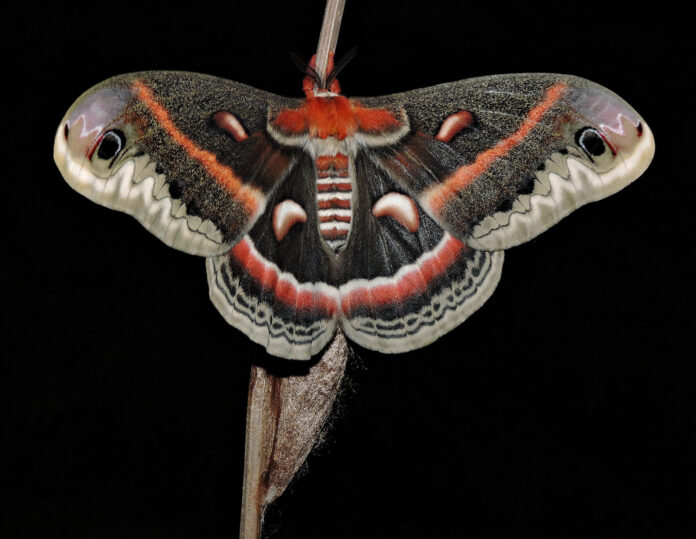
Have you ever noticed the array of nocturnal insects that come to rest beneath your porch light on a summer evening? Scrutinizing these visitors in June may result in being treated to a species of one of the largest, most magical moths in this area — the giant silk moth.
There is no ignoring this winged wonder, as it rests upon the side of your house or barn. I have been rearing Lepidoptera (butterflies and moths) most of my life, and the members of the giant silk moth family, with their tremendous size, striking coloration, and general wow-factor, have always held my greatest interest.
Here in northeast Ohio, we are home to 10 species of giant silk moths, from the Cecropia Moth, with the largest wingspan in North America, to the Royal Walnut Moth, whose giant caterpillar, the hickory horned devil, holds the largest mass. And who can overlook the delicate green Luna Moth with its twirled tails designed to jam the sonar of bats as they attempt to hunt them?
Many species have large eyespots on their lower wings. Kept under cover, these “eyes” are flashed when the insect is threatened by a predator, such as a bird, startling it long enough for the insect to make an escape.

The largest species
With immense wings measuring up to 7 inches across, the Cecropia moth (Hyalophora cecropia) bests any other species in North America. Emerging from a large, brown, silken cocoon, female Cecropias release pheromones after dark, “calling” males from up to 5 miles away. After mating for up to 17 hours, the pair parts ways the following night.
The female moth, packed with up to 300 eggs, takes flight in search of plants on which to deposit them. Each species of moth has certain flora that host their larvae.
Some moths only lay their eggs on only one species of plant, while others, like the Cecropia, have a choice of several. Cecropia caterpillars are a bluish-green with multi-colored knobs on their heads. Measuring nearly 5 inches in length, they are as big around as plump hot dogs.

When it comes to caterpillars, though, the hickory horned devil takes the prize. Not only is it a behemoth — topping out at 6 inches in length — but it is also the most spectacular in looks with its turquoise and green body and wicked orange horns tipped in black.
When confronted by a predator, the caterpillar thrashes its head around hoping to intimidate it into retreat. In reality, the caterpillar is completely harmless. When it has reached full size in late summer, it burrows beneath the soil where it will spend the winter before emerging the following year as a stunning royal walnut moth (Citheronia regalis).

Life cycle
During the month of June, adult moths emerge from their lengthy slumber, either from within a silken cocoon or an earthen cell beneath the ground. They have no mouth parts and thus do not feed.
In fact, they simply live long enough to find a mate and deposit their eggs on various host plants. In less than 10 days, they perish. These eggs, scattered among bushes and trees, hatch within two weeks, and the tiny caterpillars begin their job as full-time eating machines.
As they grow, they shed their skin. The period between sheds is termed an “instar,” and most caterpillars have five of them. During this time, the growth they experience is phenomenal, some consuming 27,000 times their body weight!
During the months of July and August, caterpillars have but one thing on their mind. When they have reached their full size and can’t muster another bite, they simply drop off the plant, hitting the ground with a loud thud. It’s time to travel, time to locate the perfect spot in which to continue their metamorphosis.
Late-summer caterpillars

It is during this crawling stage in late summer that the giant silk moth caterpillars become most conspicuous. They are often seen crossing roads and sidewalks or making their way up and down trees or the sides of buildings. It is hard not to notice one of these massive green or brown sausages as they make their way determinedly along.
During this stage, they are extremely vulnerable, becoming a meal for many predators or being squashed by an automobile or human. Unfortunately, many people equate all of these large caterpillars with the much-disliked “tomato hornworm” (which is actually a sphinx moth, not a giant silk moth) and are quick to end their lives. It is hard to imagine all the beauty that is snuffed out with such an ignorant act.
Finally, after crawling for what seems like miles, the caterpillar finds for what it has been searching. Whether it is a sheltered spot or sturdy branch on which to spin its silken cocoon or some loose soil in which to burrow deep down and form a pupa, the caterpillar is ready to enter the final, and lengthiest stage of its life.
Throughout the chilly autumn rains and frigid winter temperatures, it sleeps within its chamber. During this time, chemical changes are occurring. The pupa, once an egg, then a crawling caterpillar is morphing again.
As the warmth of spring arrives, the final changes occur and finally, in June, the moth emerges in stunning glory to take flight into the summer night.












